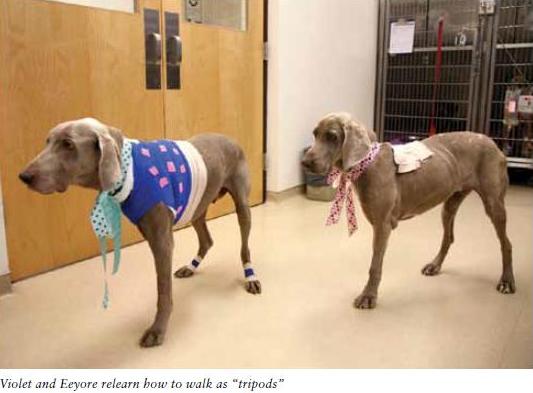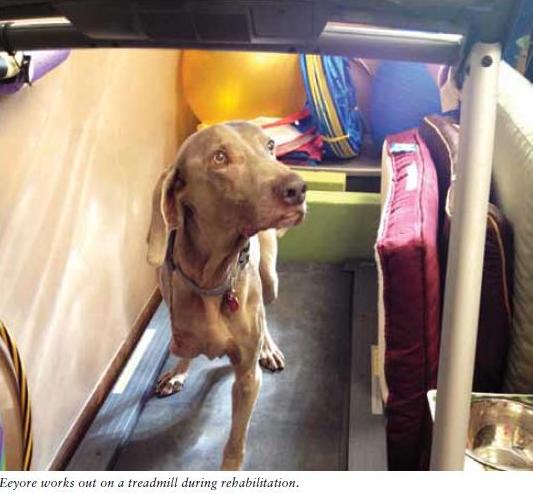
Medical and cultural shifts are making ‘tripawd’ pets more common
In January, Violet Gray was viciously mauled by a fellow dog and left for dead. The 4-year-old Weimaraner spent two days alone outside with a fractured right humerus before being picked up by Albuquerque Animal Control.
Tickled Pink Weimaraner Rescue took her to the emergency room at VCA Montgomery Road Animal Hospital, where she spent five days clinging to life. After a series of blood transfusions and medications, she was strong enough for a leg amputation. Violet was able to make a full recovery, and eventually was adopted by a veterinary nursing couple.
It may surprise you to learn that dogs and cats are better at coping with limb amputation than are humans. Animals lack the psychological stress that comes with losing a limb in a culture that places high value on physical perfection. They also have fewer fine motor skills involved in limb movement.
However, front leg amputation can present a challenge to dogs, since they place 70 percent of their body weight on their front legs. The term “tripawd” (tripod) reflects the front-legged amputee’s natural shifting of body weight onto the remaining leg. Front-legged tripawds move with a pogo-stick hop, propelling themselves forward on one leg placed in the middle of the chest. Since the center of gravity at the front of the body falls right behind the shoulders, removing one limb forces a significant shift. These tripawds may need to lean against things and may tire easily.
The challenges for rear-legged tripawds vary among breeds. German Shepherds, for example, tend to dip down low when walking, so they take longer to rebuild strength than breeds with more table-like body structures.
Pets can lose a limb because of trauma, disease, or birth defect. It may be an old fracture that didn’t repair well, or bone cancer, or a nonfunctioning limb at birth. Amputation is the most common cause among dogs, affecting maybe 1 to 5 percent of the population, said Laura Hady, a doctor of veterinary medicine and canine rehabilitation at Albuquerque’s Veterinary Emergency and Specialty Center.
Typically, artificial limbs are used only where a limb was needed for mobility or support, and where enough remains of the limb to serve as a brace. Artificial limbs are rare among animals, because it is difficult to make a prosthesis of a whole limb. X-rays must be examined to ensure the prosthesis will line up correctly, and it may not fit because of a rough amputation. In these cases, a wheelcart is often used instead.
Canine limb amputation is growing more common, thanks to advancements in veterinary medicine and because dogs have evolved from working animals to family companions. Owners are more willing to spend on pets as veterinary medicine has improved.
“I think most dogs and cats used to be euthanized, because their owners would no longer see them as fully able to fully serve their purpose as a working animal,” says Keri Pink, director of Tickled Pink Weimaraner Rescue. “Whereas today, they are treated very much as valued members of the family whose lives are worthy of many things, whether they have four legs or not. There are even some dogs living full lives with two legs.”
Growing cancer rates are another culprit. Osteosarcoma, an aggressive, malignant tumor that is the most common type of bone cancer, is the reason for many limb amputations.

The day after Violet underwent surgery, a 10-year-old male named Eeyore had his front right leg amputated because of a hemangiosarcoma, a rare, rapidly growing, highly invasive cancer in the lining of the blood vessels. The tumor was pushing on his shoulder and growing into surrounding tissue, making isolated removal difficult. Eeyore survived the surgery and lived several months in a rescue shelter before he died.
“The decision to have surgery performed on him is one that will never be regretted,” said Pink, “for Eeyore was given a chance to run and play like he had years before.”
With the cultural shift toward adopting shelter dogs, many more are being chosen that may have needed a limb amputation. “Many people are passionate about the welfare of animals, and some people are particularly concerned with the welfare of special-needs animals, such as amputees,” said Pink.
The biggest challenge owners face immediately after surgery is pain management — not only post-surgical pain, but the stress on remaining limbs to take on added work. The spine, wrist, and shoulder must now bear more weight.
Depending on the type of amputation and the overall health of an animal, accommodating changes at home might be minimal. Smaller furniture is removed initially to prevent pets from bumping into it while learning to adjust to a new center of gravity. Hardwood and tile flooring may need rugs added for traction, to prevent slipping or tripping. Smaller area rugs will have to be removed, as they can cause slipping. Some pets may need a sling, harness, or wheelcart for support. They can make use of ramps to navigate furniture and stairways.

Several types of therapy are available for dogs and cats with limb amputations, depending on the type, at different stages of recovery. Physical therapy typically incorporates Pilates-type exercises that focus on strengthening core muscles. Balls are used to strengthen abdominal and spinal muscles, and ramps, blocks, support straps, harnesses, slings, and wheeled carts aid in rehabilitation and mobility. Pets can also learn to use balance boards and ramps. Some owners turn to acupuncture and homeopathic therapies to aid rehabilitation.
“We used to think that because they got on with their life, they weren’t having issues with the remaining limbs,” Hady says of amputees. “But we’re wiser now. Pets are living longer, so people are saying, OK, how’s my dog going to be in the long run, and what can I do to help him out?”
Therapies might also include physical stimulation, such as laser treatment to help with muscle pain, a fully submerged pool, or partially submerged treadmill.
The latter was of great benefit to Bogart, a Saint Bernard and mascot for the Oscar Foundation, a nonprofit that helps cover surgery and rehab so pets don’t have to be euthanized. Bogart had bone cancer, hip dysplasia, and elbow dysplasia, which resulted in amputation. Therapy consisted of placing him in a box with a treadmill in it. Water would fill from beneath, lifting the dog and creating resistance while helping provide balance. Through stem cell therapy and weekly sessions on an underwater treadmill, Bogart was able to adjust to his new equilibrium and live a full life.
Mobility problems no danger at the zoo

Rescued off a New Jersey beach with paralyzed back flippers, the grey harbor seal known as Ziggy swims fast enough for the zoo seal tank.
Paraplegic pets aren’t the only animals being rehabilitated more than in decades past. In August, the Albuquerque zoo acquired a baby seal that had lost the use of his back flippers.
The grey seal was found beached in New Jersey with a wound to his head and partially paralyzed rear flippers. No one knows what happened to him — possibly collision with a boat propeller — since he wouldn’t have lived long if he’d been born that way. Seals’ rear flippers serve as propellers, so without them “he would be shark bait,” said Ralph Zimmerman, Albuquerque Biopark head veterinarian.
Ziggy — the name eventually chosen for him by Facebook fans — was cared for at the Marine Mammal Stranding Center in Brigantine, New Jersey, but his disability meant he could not be released into the ocean. When Biopark staff saw him listed for adoption, “we were just talking about the fact that our old girl was 44, and it may be time to look for a new seal,” Zimmerman says of the zoo’s other grey seal.
Biopark staff flew to New Jersey to accompany Ziggy to Albuquerque in a cargo plane. He was estimated to be 6 to 8 months old at that point. “Because they did so little to socialize him, we were afraid he would freak out in the airport,” Zimmerman said. “But he was fine.”
After a month in his own tank, Ziggy joined the three sea lions, three harbor seals, and old grey seal in the zoo’s Seal and Sea Lion Pool. He had been visible to the others the whole time, but when he first ventured to join them, “the big sea lion would come bark at him, and he’d go back in his tank,” Zimmerman said. Another time he encountered a group of schoolchildren, and went right back to the security of his pool.
But since early October, Ziggy has joined the others in the big tank. “He’s doing great out there,” says Zimmerman. He appears quite curious, peering at zoo visitors through the window. “He uses his front flippers well,” the veterinarian said. “He has pretty decent control, but no speed.”
Most zoos these days choose rescue animals for their marine mammal collections, Zimmerman said. “There is a more organized effort to get non-releasable animals into a permanent home.” The zoo’s bull sea lion had been found beached in California. Rather than be euthanized, in other words, marine mammals also are living full lives with fewer flippers.
